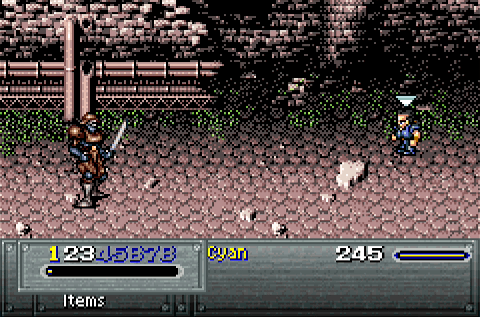
With the introduction of Cyan comes a weird new special command: Bushido (formerly SwdTech). It’s almost really interesting as a command, but it suffers from a deep flaw that renders it largely useless — or, at the very least, ensures you’ll never make use of its advanced permutations. Weirdly enough, the otherwise dreadful iOS port of FFVI changes the workings of Bushido with a single, small tweak that makes it massively more valuable. In its vanilla permutation, however, it’s largely a waste of time.

The problem with Bushido is that it preempts the rest of the game. Once you choose the menu command, a new action meter pops up, slowly advancing from 1 to 8. Press the input button again and the currently highlighted number becomes Cyan’s command; each number represents a different sword technique for him to execute.
For example: Bushido level 1 yields you Fang (formerly Dispatch). This action is a single powerful sword strike that you can basically execute immediately; it’s a single button press more complicated than the basic Attack command, yet works out to be far more powerful, especially in the early game.
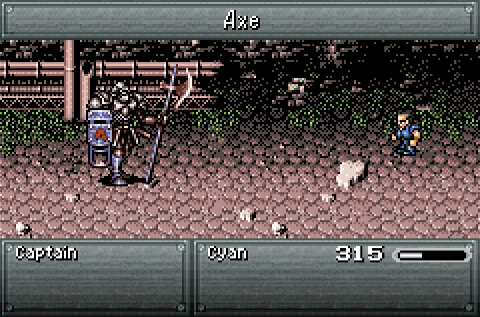
Bushido level 2 gives you Sky (aka Retort), which places Cyan into a defensive state from which he will perform a counterstrike against any enemy that hits him with a physical strike.
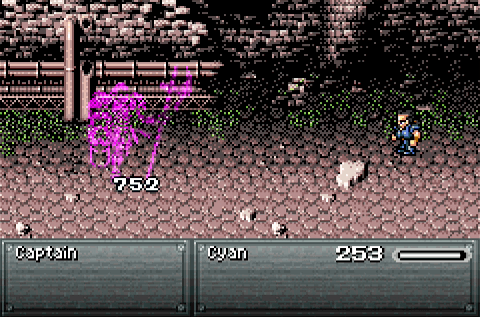
This counterblow is even more powerful than Fang. Higher Bushido levels yield instant death attacks, multiple strikes, status effects, and more.
The problem is that while Cyan’s Bushido meter is filling, so is every other meter. Your party continues to accumulate ATB charges, and so do enemies. Unfortunately, since the Bushido meter dominates the command interface, you can’t give any other party members commands while it’s active. Your enemies, of course, have no such limitations; they’ll continue to attack with impunity while you’re tied up with Cyan.
To FFVI‘s credit, though, it does a nice job of introducing you to this new skill while at the same time encouraging you not to get hung up in pointless encounters. Cyan leads a counterattack against the Imperial assault on Doma Castle, facing off against groups of soldiers singlehandedly. It’s a great chance to learn about the different abilities offered by Bushido; since Cyan is the only playable character here, the Sky command is super valuable — everyone’s going to target Cyan, meaning lots of opportunities for counters.
However, every enemy here has an extremely high chance of using a final attack: A free action performed as a counter once you land the killing blow, regardless of that enemy’s ATB status. These death attacks hit much harder than standard attacks and quickly wear down Cyan’s health in short order, and they break the rules of the game’s counterattack mechanics: These soldiers can use final attacks even if they die from Cyan’s Sky technique (typically no one in FFVI can counter a counter). So you have a chance to get a handle on Bushido in a fairly safe setting, while at the same time being encouraged to hustle along to finish off this sequence by taking on the boss to prevent Cyan’s health from being worn down completely.
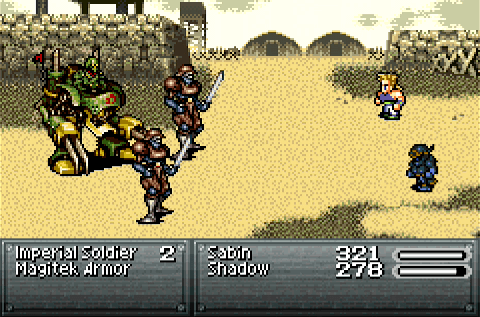
Meanwhile, your main party has to sneak through an Imperial encampment that’s set up camp in front of a bridge blocking the road to Doma and the world beyond. This is a light stealth section, and you can largely avoid conflict if you follow the dialogue cues and sneak past enemies. Of course, you can also fight your way through the encampment like you just don’t care, too.

The game rather unsubtly contrasts the two remaining Imperial generals here: General Leo commands the uncompromised respect of his men for his integrity and compassion. Kefka, not so much. But Leo gets called back from the front lines, leaving you to face off against Kefka.
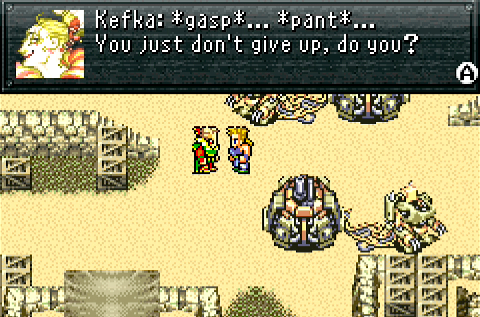
For a general, he turns out to be less impressive than one might expect, scurrying in retreat as soon as you land a blow on him.

Kefka manages to throw his underlings in your way long enough to make a break for it and enact the dumbest plot event in the entirety of FFVI: The poisoning of Doma. It’s a tragedy, yes, but it also makes no sense. Kefka poisons the water, which causes everyone in Doma to suddenly drop dead… except, inexplicably, Cyan.
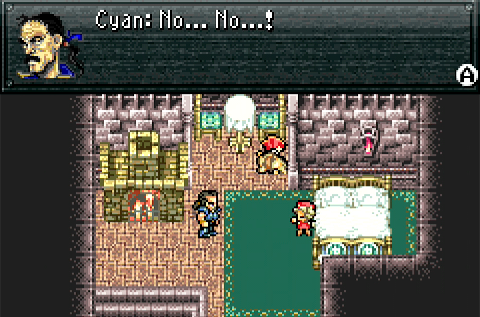
But, unfortunately, including Cyan’s family.
The idea here is sound — showcase Kefka’s wretchedness once and for all, while giving the party a new ally with a profound motivation for hating the Empire — but it’s borderline nonsensical. The way Cyan’s son flops out of bed just makes the whole thing seem goofy, too. This is one of those cases where Square’s designers really needed more than the Super NES could offer in order to express their ideas….
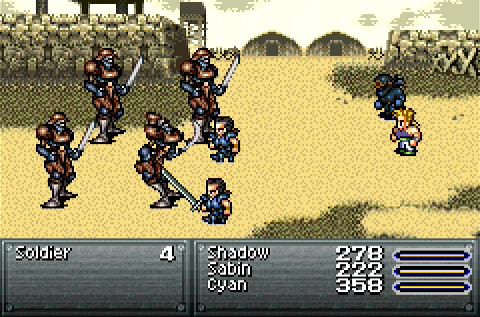
Nevertheless, this does lead in to the most intense character recruitment in the game: Cyan goes full on berserker, fighting the entire Imperial camp on his own, leaving Sabin (and, optionally, Shadow) to sit in as more or less bystanders to the event who mostly offer moral support. Eventually, Cyan begins to wear out and accepts the other men’s help, and they all scramble into Magitek armor.

All three men, of course, only have access to the basic functions that were available to Biggs and Wedge. Terra’s enhanced capabilities are nowhere to be seen, once again reinforcing the fact that she’s basically awesome.

The road leads to the Phantom Forest, where everything is undead. Observant players may have noticed the holy elemental nature of Aura Cannon; this makes Sabin the star player by far, with Aura Cannon doing ludicrous damage to everything in sight.

Observant players may also have noticed that the reflective pool here restores your HP and MP, similar to the recovery buckets in Final Fantasy IV though far more elegantly rendered.
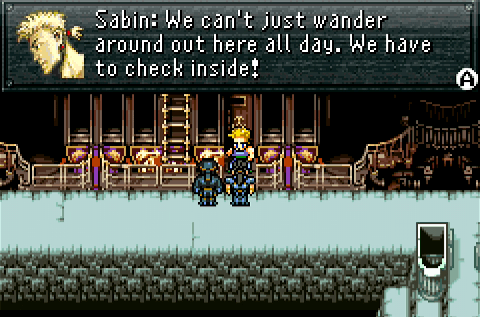
As you continue to venture into new territory during this phase of Final Fantasy VI, the game rather unapologetically railroads you in a specific direction. In this case, like it or not, lunkheaded Sabin wanders into a haunted train because what could possibly go wrong? By and large, this is how FFVI works: It features plenty of nonlinearity, but mainly in the sense of backtracking or revisiting familiar ground. As you push into regions you’ve never explored before, however, the firm hand of Game Design presses at the small of your back to prevent you from wandering off-path.
Not only are you pushed enthusiastically into the Phantom Train whether or not you like it, the subsequent adventure is probably the most literally linear sequence you’ll encounter in the entire game (at least until the Fanatics Tower, I suppose). It’s a train, a dungeon literally on rails.
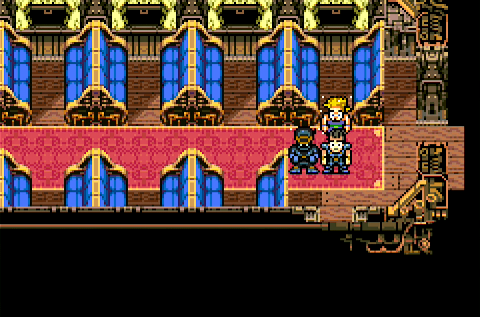
But you do get to see a rare treat if Shadow hasn’t abandoned you yet: Even the unflappable ninja warrior has a surprised sprite.

Even if you’re down to your two core characters Sabin and Cyan here, however, you can still take on the Phantom Train with a full party. The train is populated by character sprites, some of which are enemies as you’d expect… but some are ghosts who will tag along and participate in combat. It’s quite kind of them.
In fact, they’re so kind that they’ll even commit the ultimate sacrifice for the party. A ghost’s special command is Possess, which causes it to self-destruct, taking any target with it but also removing it from the party. You can return to where you recruited the ghost and team up with it anew afterwards, though this isn’t particularly practical if you have to backtrack all the way to the start to find the ghost… and impossible after the point of no return.

Despite the simplicity of this dungeon’s “design,” the Phantom Train features enough unique events to make it memorable. The setting alone is fairly unique, but then you deal with events like being pursued by a legion of undead who can only be defeated by unfastening the train’s car junctions and leaving the rear cars behind… which presumably damns every soul aboard to eternal damnation or torment or wandering or whatever, since the Phantom Train ferries the dead to the afterlife. Probably best not to think too hard about the theological ramifications.
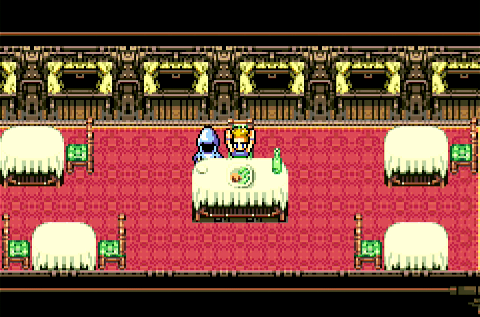
You can optionally stop to restore your party’s health in the train’s dining car. You’re given the choice not to do it, which might seem wise — don’t want to go all Persephone here, right? But actually, there are no ill effects, and it’s a nice little character-building scene for the devil-may-care Sabin and skittish, uptight Cyan.
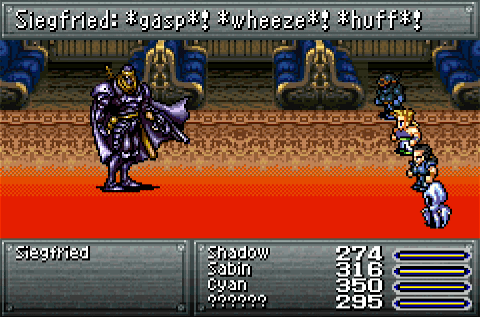
There’s also a completely useless boss battle against a pompous swordsman who ambushes you, flails about pathetically, and makes off with a treasure. Siegfried’s role or nature is never explained; it’s just a bizarre one-off encounter against a foe whose mere presence makes no sense whatsoever.
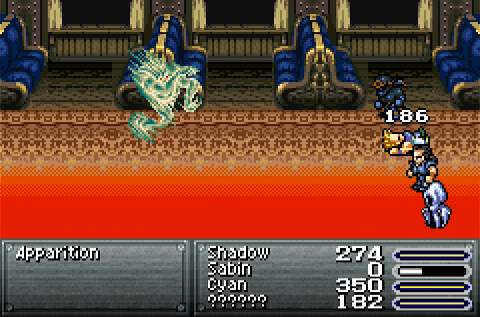
More difficult is the palette-swapped spirit enemy Apparition, which is the first time in this leg of the adventure that you’ve faced a foe casting legitimate magic spells — something that will grow much more common from here on out. Magic, at least for now, hits your party tremendously hard and poses a major threat.
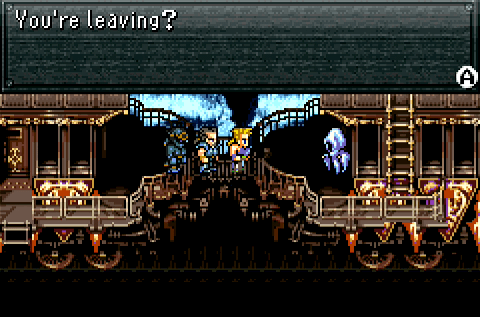
Any ghost companions you still have in tow will leave the party once you reach the engine car. Wouldn’t do to instantly-kill the upcoming boss, right? On the other hand, your erstwhile partner’s departure sends a clear signal that you need to brace for a big fight.

To engage the boss, you need to complete a small puzzle… which isn’t really much of a puzzle, since the instructions are given clearly. A weirdly pointless little exercise.
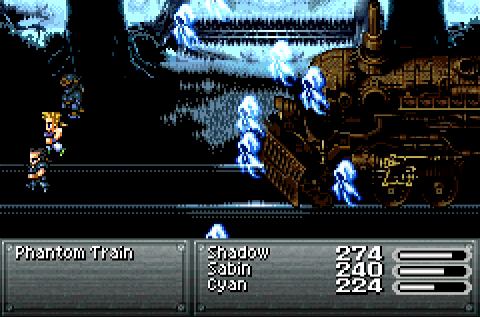
The Phantom Train culminates in a fight against… the Phantom Train. In a pretty fun twist, the final boss of the dungeon is the dungeon itself, annoyed that you’ve been ordering its denizens to commit eternal suicide and relegating half its passengers to eternal purgatory. Even though this boss is probably best know for the fact that…

…Sabin’s Meteor Strike maneuver…
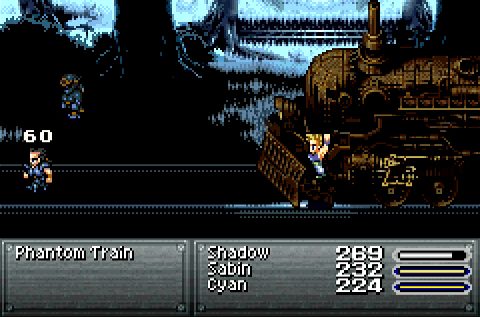
…allows him to suplex a train…
…it’s worth remembering simply for its creativity. The Phantom Train attempts to run you down as you scurry ahead of it, gaining the rear-attack advantage and using a variety of abilities against you, including a particularly nasty attack that only seems to appear if you no longer have Shadow in the party — which is a weird design choice, because you’re already at a huge disadvantage with only two party members against this boss.
Then again, like everything else in the dungeon, the Phantom Train is undead and will crumble at the touch of curative powers, and dies instantly if you hit it with a Phoenix Down.
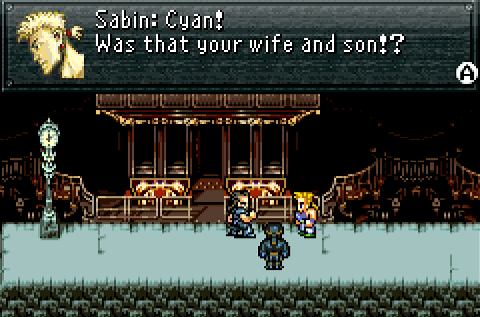
At the end of the dungeon, Sabin notices that Cyan looks like he’s seen a ghost. Because he has.
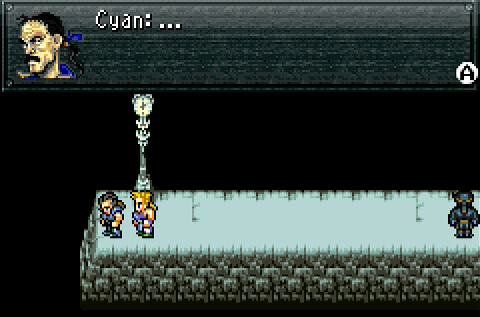
Completely unique to this sequence, this scene ends only after a specific amount of time has passed — a moment of silence, as it were. You can’t leave the dungeon of your own volition, and you can’t stick around. Cyan reflects mournfully for several seconds while you control Sabin (Shadow advises giving the other man some respectful distance), then the scene fades to black before dumping you on the world map. This unusual presentation adds a subtle emotional punch to this sequence. You can only move along when Cyan is ready to move along. It’s little details like this that make FFVI so effective at character and story development despite its overall simplicity; not how much is said, but how smartly what little it does say is presented.
Always suplex the train! Hell I bought a t-shirt that looks like a comic book cover, showing Sabin suplexing that train.
How the heck did you find this entry? It’s not publicized in social media, and it’s hidden from all feeds and indices.
I’m not certain, but are these articles automatically publishing on your Google+ feed earlier than you’d meant them to? I thought I’d seen some of them show up when it was still Patreon access or something before.
Nope, I’ve completely disconnected it from all social media.
I love Cyan. In boss battles, I would make everyone else go first, then charge up Bushido so that no one else’s time em was being wasted. It never seemed like SUCH a huge drawback to wait, but I’m sure the returns are diminished later on.
I always made a point of switching up the leader in the dining car, so everyone got to reluctantly eat ghost food.
I guess it’s more accurate to say his skill is great at the start and useless later.
When I played this game for the first time, I had no concept whatsoever of mechanics, min-maxing or any other term connected to RPGs. Hence, with Cyan and Edgar having served me well in the first hours of FF III, they were mainstays of my party for the final fight as well.
Guessing the iOS version of the game lets Bushido charge in the background while other characters still get to do stuff? Yeah, that’d be a game changer.
The guys on Brontoforumus and I BS’ed awhile back about how the game could be redesigned to improve its balance. That was one of the fixes somebody suggested. (Someone — I think it was Brent? — suggested removing the Fight command entirely and doubling down on every character’s unique command. You’d need to do something about commands like Steal which don’t deal damage so that Locke would be able to win a fight on his own and without the Thief Glove, but I think it’s an interesting idea.)
A minor correction: not all the monsters on the Phantom Train are undead. There are Bombs, and I think the little mage guys are also not undead. Possess only works on undead foes.
While I’ve never tried it myself, my understanding from the internet is that Possess will, in fact, work on anyone. A.n.y.o.n.e. If you use a glitch or cheat to put the Ghost or Possess command in your party, it can instantly kill the final boss.
FFVI is my favorite game of all time, so im loving this anatomy, even though i do feel the pain with the constant jabs at the game design or plot twists, which granted, wouldnt make sense if rendered in the hyperrealistic graphics and plot expectations of today.
It will take forever to get to the end, but i can wait
For a long time I’d wondered if something was lost in translation in the original US FFIII that would shed light on the mystery of “What the hell is up with Siegfried anyway?”. But near as I’ve been able to tell, aside from some naming inconsistency, the answer is no? It really does make one wonder if once, at least in some designer’s head, there was a larger sub-plot involving him that mostly got cut for time leaving just a few disjointed encounters.